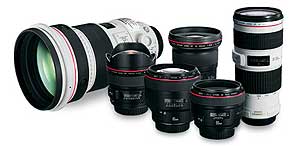Contact Details: Scotch Macaskill, Dirt Road Traders, Currys Post Road, Howick, KwaZulu-Natal, South Africa. Tel: +27 (0)82 578 2329. Privacy: Your privacy is guaranteed. See our Privacy Policy for more. This site accepts advertising and other forms of compensation - see Disclosure and Advertising for details. Site updated: 2022. Copyright © 2002 - 2022 Scotch Macaskill

| ||||||||||
|
||||||||||
|
See Also: |
Canon L Lenses Canon L lenses are designed for professional use and carry the "L" designation in the
Canon L lenses are designed for professional use and carry the "L" designation in the
description. They also have a red ring around the lens barrel that visually distinguishes them from Canon's regular lenses. Canon sometimes refer to these lenses as "luxury" lenses and it's popularly accepted that the "L" stands for luxury. As tools made for professional photographers, L-series lenses are expected to produce images that are sharp and crystal clear with excellent color rendition. To meet these requirements, Canon utilizes three optical materials in its L lenses:
Rugged Build QualityIn addition to these specialized optical features, Canon L lenses have to withstand the rigors of professional use, from the mud and sludge of combat situations to snow, rain, and dust that wildlife and nature photographers encounter. To achieve this, L lenses are made with rubber seals at interface areas such as switch panels, exterior seams, drop-in filter compartments and lens mounts. Moving parts such as the focusing and zoom rings and switches are designed to keep out dust and moisture to ensure reliability under adverse conditions. Low Light PerformanceProfessional photographers often have to shoot in low light conditions, such as indoor sports events or outdoor arenas under artificial lights at night. Wildlife photographers get their best shots in early morning or late afternoon, when the animals are most active and the sun is low in the sky. Wedding and press photographers often prefer using available light above flash to get a more natural look and require fast lenses for this. In all these situations, L-series lenses are invaluable with their wide maximum apertures, allowing optimum low light performance without requiring a boost in ISO to unusable levels. While all Canon's big "white" lenses (except for the unusual EF 400mm f/4 DO) are L lenses, there are many L-series lenses, both prime and zoom, that are black, particularly in the wide angle and portrait focal lengths. Below is the current lineup of Canon L lenses: 1. Prime Lenses
2. Zoom Lenses
4. Tilt-Shift LensesCanon TS-E 24mm f/3.5L
3. Macro LensesCanon EF 100mm f/2.8L Macro IS USMCanon EF 180mm f/3.5L Macro USM Return to Canon Lens Reports |
|||||||||
|
|
||||||||||